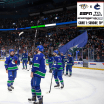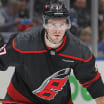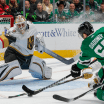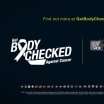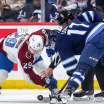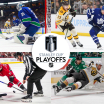Goaltending plays an integral part in the Stanley Cup Playoffs, so NHL.com is breaking down the battle between the pipes in each series, charting goals to find strengths, weaknesses and targetable tendencies.
Martin Jones and the San Jose Sharks already knocked off one goaltender known for his aggressive, athletic style by eliminating his former team, the Los Angeles Kings and Jonathan Quick in the Western Conference First Round. Now they face a similar style in the second round against Nashville Predators goalie Pekka Rinne.
Predators veteran Rinne similar to Sharks newcomer
Nashville starter has more experience, slight advantage over Jones in second round
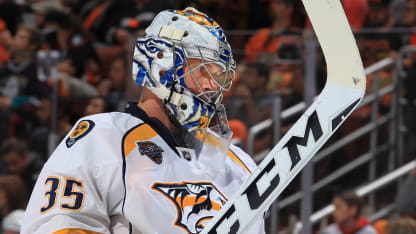
© Debora Robinson/Getty Images
By
Kevin Woodley
NHL.com Independent Correspondent
Jones continued to build off 37 wins in his first season as a starter with a solid playoff debut against the Kings, and Rinne, who had an inconsistent regular season, channeled the athletic form that made him a three-time Vezina Trophy finalist. After giving up 11 goals in losing three straight games, Rinne stopped 62 of 64 shots winning the final two games, including 36 saves in eliminating the Anaheim Ducks with a 2-1 victory in Game 7 on Wednesday.
POSITIONING: If you want to get a feel for Rinne's aggression, watch him when the Sharks break out of their end: He taps his posts when play hits center ice and charges out several feet beyond the top of his crease, stopping suddenly, and before retreating times it with the approaching rush. With a style based on aggression, Rinne may have more moving parts than any NHL goalie.
Jones is the opposite, with a playing style and positioning that match the calm demeanor teammates so often praise him for. Jones plays a more patient, controlled game on his skates, wandering slightly past the top edge of his crease on rush chances but playing more at a three-quarters depth within the blue ice when play is in the San Jose end, and challenging more when he reads a clean chance. Jones got caught chasing a play well wide of his crease on the first goal of the series against Los Angeles, but for the most part stuck with his more contained positional approach.
Like most things in goaltending, there is give and take. Jones' controlled style tends to lead to more consistency but is more exploitable around the edges of the net. Rinne's style relies more on timing and rhythm and can be more prone to highs and lows, but it's also harder to pick apart, especially when the Predators defense is protecting the area in front of the net as well as they have so far, limiting the lateral exposure that comes from getting caught chasing a play aggressively beyond the crease.
Advantage: Jones, because his positioning is less reliant on rhythm over what could be a long a series.
BLOCK/REACT THRESHOLD: Rinne's impressive glove hand has been well documented and he has roots playing a Finnish version of baseball. He catches pucks on the other side of his body and scoops them off the ice in front of his pads, controlling rebounds other goalies would kick back into play. Rinne has the lowest 5-on-5 high-danger save percentage in the playoffs (.7273), according to war-on-ice.com, which matches him having the lowest among goalies to play 6,000 minutes since 2012 (.8088).
Jones is at his best when his patience on his skates is matched by his tracking into shots, which allows him to stay active with his hands, but when he starts pushing to the ice with his knees straightening up his upper body above that and pulling back with his hands on the shot release, it not only leaves him exposed up high but sets up delays and coverage deficiencies in his recovery movements. It's a trend that is more prevalent on his blocker, and after movements to that side, one that can be targeted with increased traffic because he prefers to look up and over screens, which can leave him a little exposed along the ice and under the pads, something that led to two goals against the Kings.
Advantage: Rinne, because there were signs Jones was pulling off shots late in the season.
PUCKHANDLING: Rinne handles the puck a lot better than he typically gets credit for and has used it to stay active and engaged when he adjusts to seeing fewer shots the past two seasons, but he can get overly aggressive at times, even going behind the net to try to corral dump-ins high up on the glass, a no-no for most because of the increased risk of bad bounces that end up in front of an empty net.
Advantage: Rinne, because of how often and well he moves it now. Jones isn't bad playing the puck, making smart, simple plays to help alleviate pressure and start breakouts, but Rinne is better.
POST PLAY: Rinne likes to hold his skates rather than defaulting early to his post-seal techniques, a patient approach that aids his mobility moving off the posts but leaves him more vulnerable to getting caught transitioning his long legs down to the ice on low plays from bad angles and behind the net, including a go-ahead goal by Anaheim's Ryan Garbutt from below the goal line in Game 5. It also seems to produce a lot of frantic scrambles around Rinne's crease for a goalie who should big enough to take away most dead-angle scoring options from his knees and without having to move so much.
Jones employs a variety of post-integration techniques depending on the type of attack and its proximity to the goal line, including the use of a traditional VH, with the lead pad stacked vertically up against the post and the back pad lying horizontal on the ice, on plays from above the goal line. He prefers reverse-VH, with the post pad down on the ice, when the puck is behind the net, and though he won't linger in it too long, he was burned five-hole a few times by opening up on wraparounds and walkouts during the season.
Advantage: Jones, because his default is to take away plays that lead to cringeworthy goals.
SCORING TRENDS:As active as Rinne is with his hands, he knows reaching too much opens up holes that teams will try to exploit with redirections, something that shows up in his lower-than-expected high-danger save percentages. It's also important to win battles to get to the front of the net, which is easier said than done against Nashville's defense, and be available and ready for loose pucks that catch the big goaltender scrambling back after making aggressive initial saves.
Jones' more conservative approach leads to more stereotyped exposure around the perimeter and into the high corners of the net, but the typical calls for traffic do tend to create very specific tracking issues that exacerbate this exposure high and lead to delays into his second-chance movements. Those trends are more noticeable moving to the blocker side, where a lack of rotation in his movements on the knees and skates tends to leave him coming across flat and off angle when he arrives.
Advantage: Rinne, because his unpredictable style is harder to game plan and can frustrate shooters.


